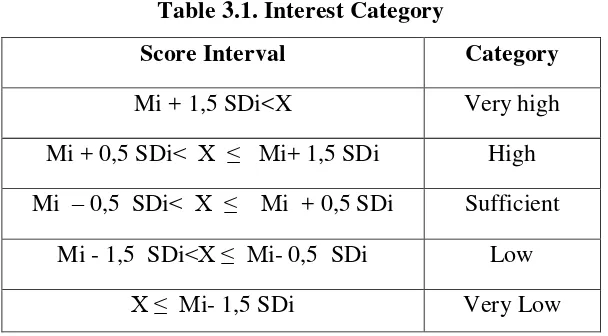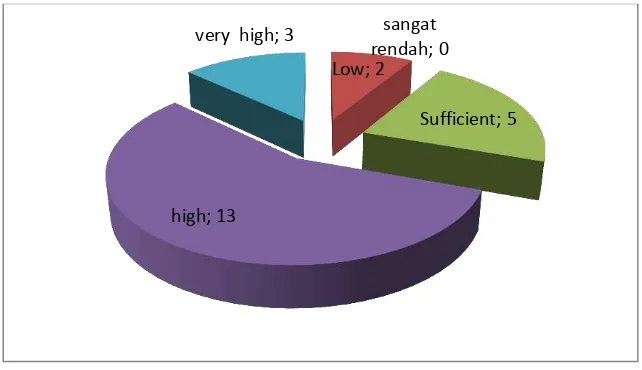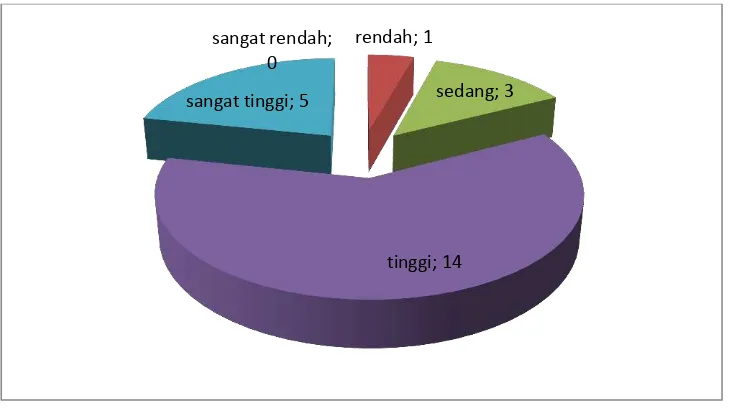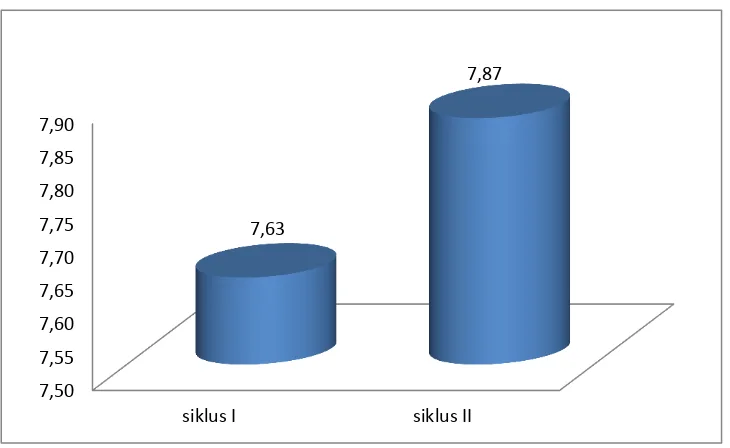290 TEAMS GAME TOURNAMENT FOR IMPROVING
THE STUDENTS‟ INTEREST TOWARD MATHEMATICS
Anggit Prabowo
Ahmad Dahlan University, Yogyakarta, Indonesia Email: [email protected]
Abstract
This study aims to identify how the teams game tournament has a capacity to improve the students‘ interest toward mathematics.
This study was a classroom action research that conducted in two cycles. The reasearch subjects were the students of VIIIB of SMAN 2 Klaten. The research object were the process of teaching and learning in the classroom and the students‘ interest toward mathematics. Data were collected by questionnaire, interview, and documentary. Data were analyzed by descriptive analysis.
The results show that teams game tournament has a capacity to improve the students‘ interest toward mathematics. The score of students‘s interest toward mathematics increase from first cycle to second cycle. The are 70% of students that have interest in mathematics (high and very high) in the end of the first cycle and 83% in the end of the second cycle.
Keywords: interest, mathematics
Introduction
Improving the quality of human resources cannot be separated from the role of education. PembukaanUndang-undangDasar 1945 states that one of the purposes of the Republic of Indonesia,is making the Indonesian intelligent. The article 3 of Undang-UndangDasarRepublik Indonesia Number20 year 2003 states that national education serves to develop the ability and character development and civilization of dignity in the context of the intellectual life of the nation, aimed at developing students' potentials in order to become a man of faith and fear of God Almighty, noble, healthy, knowledgeable, capable, creative, independent, and become citizens of a democratic and accountable. In addition, it is mentioned in the strategic plan that the Ministry of National Education of the National Medium Term Development Plan (RPJMN) 2010-2014 aimed to consolidate the restructuring of Indonesia in all fields by emphasizing efforts to improve the quality of human resources, including development of science and technology and the strengthening of economic competitiveness.
One of the disciplines that play a role in the development of science and technology is
291 statistics. Because mathematics playsvital role in the globalization era, mathematics education in Indonesia is required to prepare in order to deal with the development of science and technology. Mathematics education should be able to prepare the learners with the knowledge and skills to the challenge in the era of globalization.
Mathematics was learned from basic education to higher education. Mathematicslearning is implemented at every level of education different from one another. Mathematics at the secondary school level, includes four aspects: number, algebra, geometry and measurement, statistics and opportunities.
Based on the reports ofProgramme for International Student Assessment (PISA) in 2009, the quality of mathematics education in Indonesia is below average. This is evidenced by the results of a test where Indonesia got a score of 371 which put Indonesia ranks 61 from 65 participants. If compared with neighboring countries, Singapore, Indonesia is still behind far. Singapore is ranked second with a score of 562 (OECD, 2010: 135).
The quality of learning is influenced by several factors. Bridge (1979: 10) states that the learning process is influenced by: a) the students characteristics, b) the family background, c) the physical characteristics of the students, d) the characteristics of the teacher, and e) the school characteristics. Djamarah (2008: 175) states that learning activity is influenced by the purpose of teaching, teachers, educators, facilities and infrastructure, learning activities, environment, materials and evaluation, and learning atmosphere.
There are several factors that lead to low student learning outcomes. Zulkardi (2007) states that low levels of student learning outcomes are caused by several factors: (1) complicated curriculum, (2) many and difficult material, (3) the traditional teaching methods and interactive; (4) less effective learning media, and (5) a bad evaluation.
Some conditions above consistent with the fact that occur at SMA N 2 Klaten. Interview with the mathematics teacher informed that the study of mathematics conducted using conventional approaches. Learning conducted by order of the teacher explained, giving
examples of problem solving, then gives exercises. Students do not take an active role during the learning of mathematics.
292 The problems mentioned above indicate low interest in students to follow the learning of mathematics. Djemari (2008: 112) defined the indicators of interest in mathematics include the benefits of learning mathematics, trying to understand the math, reading math books, asked the class, ask a friend, ask other people, and do math.
Low of the interest studentsof Klaten 2 Senior high school in mathematics allegedly affected by teacher-designed learning activities. DjemariMardapi (2010: 43) defined that teachersaffect to the quality of learning. Therefore, the teacher's role in creating meaningful learning should be improved. As has been explained above, the study of mathematics held at
the school is the traditional method and is not interactive. Hence, to overcome this problem, efforts are needed to determine the interactive learning and meaningful mathematics learning
model.
Expected learning model is a model of learning that is meaningful, involving the active participation of students, and is able to change the paradigm of teaching and learning. The learning model is also expected to realize the interaction among students and between students and teachers. This is consistent with what is being said Mathew Mitchell (Woolfolk, 2009: 384) that the use of the learning group can enhance the students‘of junior high school interest in math.
The learning model that is suitable with the principles above are cooperative learning model. Cooperative learning is learning that involves interaction among learners. Slavin (2006: 255) defined "Cooperative Learning Instructional approaches in the which students work in small mixed ability groups". Cooperative learning is an instructional approach in which students work in heterogeneous small group. While Gillieset. all. (2008: 97) defined―Cooperative learning teams were used as a vehicle to get students to engage in academic interactions that would further Reviews their understanding of what had been taught (National Reading Panel)‖. The essence of the above statement is that the cooperative learning group serves as a means to engage students in academic interactions that would hang
them on the material being studied.
293 TGT is the most unique learning model. Activities designed in this study involves academic tournament. In general, classes are grouped into several groups of 4-5 members. Each group consists of heterogeneous members. Each team has members who are capable of high, medium, and low. Thus, the ability of the team is equal. Next, each representative group join the tournament according to his ability. The smart students solve the difficulty problems. Each playersrives for the best player. Based on the description above, it was needed to have a research entitled: Teams Games Tournament (TGT) for Improving the Student Interest in Mathematics.
Research Method
This research wasa Classroom Action Researchconducted collaboratively with the
mathematics teacher of Klaten 2 Senior High School. The research model used in this study is action research model developed by Kemmis and Mc. Taggart. Each cycle of the action
research includes four components as shown in the figure below.
Subjects of this research were students of class XA Klaten 2 Senior High School. The research objectswere the process of mathematics learning with TGT and the students‘ interest in learning mathematics.
294 Table 3.1. Interest Category
Score Interval Category
Mi + 1,5 SDi<X Very high
Mi + 0,5 SDi< X ≤ Mi+ 1,5 SDi High Mi – 0,5 SDi< X ≤ Mi + 0,5 SDi Sufficient
Mi - 1,5 SDi<X ≤ Mi- 0,5 SDi Low X ≤ Mi- 1,5 SDi Very Low Mi= Mean
SDi = Ideal Standard Deviation X = Score
Indicators of success in this research is 75% of students have a high or very high interest toward mathematics and the average percentage score of 70% interest in the ideal score.
Research Finding and Suggestion
A. Research Finding
1. Students‘s interest towards mathematics
[image:5.595.67.531.571.687.2]This study was conducted in two cycles. The result of this research showed the description of the students‘ interest toward mathematics. Table 4.1.show a map of the criteria scores of high school students' interest Class XA N 2 Klaten 2011/2012 school year to mathematics.
Tabel 4.1. Peta Kriteria Minat Siswa Kelas XA SMA N 2 Klaten terhadap Matematika
Interest Category
Pre Cycle Cycle I Cycle II
n Percentage n Percentage n Percentage
Very low 2 9% 0 0% 0 0%
Low 3 13% 2 9% 1 4%
Sufficient 6 26% 7 30% 3 13%
High 9 39% 13 57% 14 61%
Very high 3 13% 3 13% 5 22%
Total 23 23 23
295 students have sufficient interest, 9 students have high interest, and 3 students have very high interest towards mathematics. Figure 4.1 describe that result clearly.
Figure. 4.1Students‘ Interest toward Mathematics (Pre Cycle)
TGT was implemented at cycle I. In the end of this cycle, students‘ interest toward mathematics were measured. The category of students‘ interest toward mathematics areno students who have very low interest, 2 students have low interest, 5 students have sufficient interest, 13 students have high, and 3 students have very high interest towards mathematics(Figure 4.2). Based on pre-defined indicators of success, this research has not been successful, because there is only 70% of all students who are interested in the high and very high on the math and the average score of the student's interest is less than 70% of the ideal score.
Figure. 4.2. Students‘ Interest toward Mathematics (Cycle I) very low; 2
low; 3
sufficient; 6 high; 9
very high; 3
sangat rendah; 0 Low; 2
Sufficient; 5
[image:6.595.155.476.543.728.2]296 Researchers further reflect on their learning in cycle I. Here are reflections of the cycle I.
1) The division of the group is unefficient. The division of the group performed at the beginning of learning. The teacher read the studentsgrouping. It make the class unconditional and waste the time.
2) When solving problems, students intergroup collaboration. Some students are still unfamiliar with the previous study that they are allowed to work together to solve problems. In fact, the type of learning with the learning model TGT their friend is a rival to be defeated.
The result of reflectionsare used to determine corrective at the second cycle. Here arethe improvement efforts implemented at the second cycle.
1. The division of the group in the second cycle conducted at the meeting before the meeting at the second cycle. By this strategy, when learning the second cycle, students gather with their own group directly.
2. Before the tournament conducted, teachers told that students between groups are a rival. Thus, there is no collaboration intournament.
[image:7.595.117.482.533.737.2]After the improvement in the second cycle, at the end of the second cycle showed that from 23 students, no student has low interest, 1 studenthas low interest, 3 students have sufficient interest, 14 students have high interest, and 5 students have very high interest towards mathematics (figure 4.3).
Figure 4.3. Students‘ interest toward Mathematics (Cycle II) sangat rendah;
0
rendah; 1
sedang; 3
297 At the end of the second cycle, 83% of studentshave high and high interest towards mathematics. The average score of the students' interest in mathematics is 73% of the ideal score (Table 4.2). Based on the indicators of success, this research is successful.
Table 4.2. The Score of Students‟ Interest toward Mathematics
PreCycle Cycle I Cycle II
Average Percentage Average Percentage Average Percentage
40,91304 56% 41,6087 57% 53,08696 73%
The results of the reflection at second cycle show that TGT run well. There are conditional class. In addition, the group has been established a healthy tournamentsbetween the groups.
2. Minimum Mastery Achievement Criteria (KKM)
Criteria for the minimum mastery in mathematic in SMA N 2 Klaten is 7.5. In this research, KKM has been reached in each cycle. At the first cycle, the average of KKM is 7.63 and the second oneis 7.87 as presented in Figure 4.5.
Figure 4.5. The KKM of Mathematics
Discussion
Students 'interest towards mathematics includes students' interest towards mathematics and learning. Interest is one aspect of the affective domain has a significant role
to the success of student learning (Begle, 1979: 87). Students who are interested in 7,50
7,55 7,60 7,65 7,70 7,75 7,80 7,85 7,90
siklus I siklus II
7,63
298 mathematics tend to gain maximum learning results. To that end, the interest should be developed and improved. Increasing interest in a lesson can be done by applying learning involves the active participation of students (Woolfolk, 2009: 384).
Teams Games Tournament (TGT) is a cooperative learning model that involves the active participation of students. These lessons can be applied in mathematics. In this method, students are involved in the academic activities of the tournament.
Students of class XA of SMA N 2 Klatenat 2010/2011 academic year have problems related their interest in mathematics. At begining, the average of students‘ interest towards mathematics was sufficient. Having implemented the mathematics learning with cooperative learning (TGT) in the class, there is increasing interest in the students towards mathematics. Having conducted in two cycles, the average interest of the students towards mathematics increased to very high.
Besides being able to increase the students‘interest towards mathematics, TGT also increase the score of KKM mathematics students. KKM of mathematics at SMA N 2 Klaten is 7.5. The results showed that at the end of the first cycle, the KKM students are reached, 7.6 at cycle I and 7.87 at cycle II. This is suitable to Arends (1997: 111) that state that one goal of cooperative learning is to increase student academic achievement.
Based on the results of research and discussion, it can be concluded that the TGT can increase the students‘ interest toward mathematics at class XA of SMA N 2 Klatenat toward mathematics. In addition, TGT also able to improve the students‘achievement of class XA of SMA N 2 Klaten.
Conclusion and Suggestion
A. Conclusion
Based on reflection during the study period can be concluded that TGT has capability to increase the studentsinterest of students of class XA SMA N 2 Klaten 2011/2012 academic year.
B. Suggestion
Based on the results and findings of the research related to mathematics learning
299 1. To avoid boredom and to increase the interest of students towards mathematics, mathematics
learning should be implemented with a variety of methods involving the active participation
of students.
2. To achieve effective learning, teachers should prepare and implement a lesson plan carefully.
REFERENCE
Arends, R.I. (1997). Classroom instruction and management. United States of America: The McGraw Hill Companis, Inc.
Bridge, R. Gray. (1979). The determinant of educational outcomes. USA: Ballinger Publishing Company.
DepartemenPendidikanNasional.(2009).
Rencanastrategisdepartemenpendidikannasionaltahun 2010-2014.
Djamarah, S. Bahri. (2005). Guru dananakdidikdalaminteraksiedukasi. Jakarta :RinekaCipta. DjemariMardapi. (2008). Teknikpenyusunaninstrumentesdannontes.Yogyakarta:
MitraCendekia Offset.
... (2010). Pengembangan moden penjaminan mutu perbaikan hasil ujian nasional SMP/SMA. Jakarta: Pusat Penilaian Pendidikan Balitbang Diknas.
Gillies, R.M. Adrian, A & Jan, T. (2008). The teacher‟s role in implementing cooperative learning in the classroom. Australia: Springer.
OECD .(2010). PISA 2009 results: What students know and can do – Studentperformance in
reading, mathematics and science (Volume I).
Diaksesdarihttp://dx.doi.org/10.1787/9789264091450-en pada 20 Januari 2012 Muijs, D., Reynolds, D. (2005). Effective teaching evidence and practice. (2nd ed.).
Thousand Oaks: Sage Publication, Inc.
Slavin, R.E. (2006). Education psychology “theory and practice‖(Eighth Edition). Johns Hopkins University: Pearson Education International.
... (2010). Cooperative learning: theory, research, and practice. Second Edition.Massachusetts :Allyn and Bacon Publishers.
Woolfolk, A. (2009). Educational psychology. Boston: Pearson Education.



